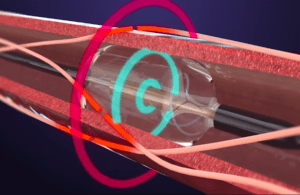
Otsuka Medical Devices’ Recor Medical announced another set of positive study results for its Paradise ultrasound renal denervation (uRDN) system.
A combined analysis of six-month follow-up data from three RADIANCE global studies evaluated Paradise as a hypertension treatment. The analysis demonstrated maintained blood pressure (BP) reduction following treatment with uRDN compared to sham. It also saw fewer antihypertensive treatments added in the treatment group.
The data provides further support for the renal denervation system, which looks the most likely to garner the first FDA nod for treating hypertension. An FDA panel in August voted in favor of the Paradise uRDN system and the company continues to work toward premarket approval. The same panel voted against recommending Recor’s closest competition, Medtronic’s Symplicity Spyral, a day later.
Co-principal investigator Dr. Ajay Kirtane presented the results at the 35th annual Transcatheter Cardiovascular Therapeutics (TCT) symposium.
“One of the key questions often asked about renal denervation is whether it is durable, especially in comparison to (or in combination with) antihypertensive medications. In this pooled analysis from the three sham-controlled clinical trials in the RADIANCE program, we observed a continued effect of uRDN at 6 months even with a backdrop of intensive monthly escalation of medications to try to achieve blood pressure control,” said Dr. Kirtane. “These data support the role of uRDN as a useful adjunct to established antihypertensive therapies.”
More on the Recor Medical data
The pooled analysis includes data collected through six-month follow-up from 506 patients randomized in three RADIANCE studies.
Recor Medical said the analysis demonstrated fewer medications added in the uRDN group at six months compared to sham. The difference in daytime ambulatory systolic BP between groups after adjusting for medication also favored Paradise. Similarly, office and home systolic BP differences over six months favored uRDN.
The company reported few safety outcomes that did not differ between groups.
“Following the two-month primary endpoint period for each RADIANCE study, our goal was to add antihypertensive medications for each patient with still uncontrolled BP to drive their BP to control, or less than 135/85 mmHg by home BP measurement. Notably, fewer medications were added in fewer patients in the uRDN group while they also achieved a significantly lower average BP than the sham group,” said co-principal investigator Michel Azizi, professor of medicine at Université Paris Cité, Hôpital Européen Georges Pompidou, Paris, France. “The maintained reductions in BP provide further evidence of the effectiveness of uRDN as an additional therapy option for treating patients with uncontrolled hypertension.”
Recor’s Paradise system holds a CE mark for treating hypertension in Europe. It remains investigational in the U.S. and Japan.